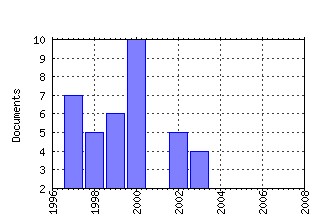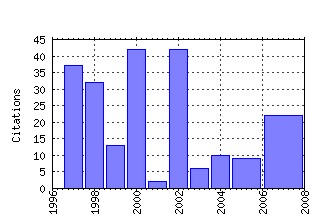
|
|
||||||||||||||||||||||||||||||||||||||||||||||||||||||||||||||||||||||||||||||||||||||||||||||||||||||||||||||||||||||||||||||||||||||||||||||||||||||||||||||||||||||
Suntory and Toyota International Centres for Economics and Related Disciplines, LSE / STICERD - Distributional Analysis Research Programme Papers Raw citation data, Impact Factor, Immediacy Index, Published documents, Citations received, , Most cited papers , Recent citations and documents published in this series in EconPapers.
Most cited documents in this series: (1) RePEc:cep:stidep:01 Does the Labour Market Explain Lower Female Schooling in India? (1997). (2) RePEc:cep:stidep:28 The Political Economy of Government Responsiveness: Theory and Evidence from India (2000). (3) RePEc:cep:stidep:33 Can Labour Regulation Hinder Economic Performance? Evidence from India (2002). (4) RePEc:cep:stidep:35 Social Networks and Technology Adoption in Northern Mozambique (2002). (5) RePEc:cep:stidep:48 Making Autocracy Work (2007). (6) RePEc:cep:stidep:13 Land Reform, Poverty Reduction and Growth: Evidence from India (1998). (7) RePEc:cep:stidep:11 Intrahousehold Resource Allocation in Rural Pakistan: A Semi-parametric Analysis (1998). (8) RePEc:cep:stidep:42 Gender Discrimination and Growth: Theory and Evidence from India (2004). (9) RePEc:cep:stidep:26 Is Child Work Necessary? (2000). (10) RePEc:cep:stidep:44 Political Selection and the Quality ofGovernment: Evidence from South India (2005). (11) RePEc:cep:stidep:18 School Participation in Rural India. (1999). (12) RePEc:cep:stidep:07 Inequality, Unemployment and Contemporary Europe (1997). (13) RePEc:cep:stidep:25 Private Investment and Political Uncertainty (2000). (14) RePEc:cep:stidep:49 Just Rewards?Local Politics and Public ResourceAllocation in South India (2007). (15) RePEc:cep:stidep:29 Modernisation and Son Preference (2000). (16) RePEc:cep:stidep:24 Child Farm Labour: Theory and Evidence (2000). (17) RePEc:cep:stidep:40 Do Rural Banks Matter? Evidence from the Indian Social Banking Experiment (2003). (18) RePEc:cep:stidep:20 Fertility, Education and Development: Further Evidence from India (2000). (19) RePEc:cep:stidep:19 On the Structure of Tenancy contracts: Theory and Evidence fron 19th Century Rural Sicily (1999). (20) RePEc:cep:stidep:09 The Economics of Poverty in Poor Countries (1998). (21) RePEc:cep:stidep:16 Minority Representation and Policy Choices: The Significance of Legislator Identity. (1999). (22) RePEc:cep:stidep:36 The Role of Freedom, Growth and Religion in the Taste for Revolution (2002). (23) RePEc:cep:stidep:30 What Makes a Revolution? (2001). (24) RePEc:cep:stidep:17 Public-Private Partnership for the Provision of Public Goods: Theory and an Application to NGOs (1999). (25) RePEc:cep:stidep:45 The Unequal Effects of Liberalization: Evidence fromDismantling the License Raj in India (2005). (26) RePEc:cep:stidep:39 Eviction Threats and Investment Incentives (2003). (27) RePEc:cep:stidep:02 Development and Thinking at the Beginning of the 21st Century (1997). (28) RePEc:cep:stidep:14 Ethnic Diversity, Mobility and School Funding: Theory and Evidence From Kenya (1999). (29) RePEc:cep:stidep:34 Land Distribution, Incentives and the Choice of Production Techniques in Nicaragua (2002). (30) RePEc:cep:stidep:08 Hunger in the Contemporary World (1997). (31) RePEc:cep:stidep:03 Whats the Point of a Development Strategy? (1997). (32) RePEc:cep:stidep:15 The Economics of Non-Governmental Organisations. (1999). (33) RePEc:cep:stidep:37 Democracy and Education Spending: Has Africas Move to Multiparty Elections Made a Difference to Policy? (2003). Recent citations received in: | 2008 | 2007 | 2006 | 2005 Recent citations received in: 2008 Recent citations received in: 2007 (1) RePEc:ces:ceswps:_2016 The Growth Effect of Democracy: Is it Heterogenous and how can it be Estimated? (2007). CESifo GmbH / CESifo Working Paper Series (2) RePEc:cpr:ceprdp:6339 The Growth Effect of Democracy: Is It Heterogeneous and How Can It Be Estimated? (2007). C.E.P.R. Discussion Papers / CEPR Discussion Papers (3) RePEc:igi:igierp:322 The growth effect of democracy: Is it heterogenous and how can it be estimated? (2007). IGIER (Innocenzo Gasparini Institute for Economic Research), Bocconi University / Working Papers (4) RePEc:qed:wpaper:1128 The Leader as Catalyst: On Leadership and the Mechanics of Institutional Change (2007). Queen's University, Department of Economics / Working Papers Recent citations received in: 2006 Recent citations received in: 2005 Warning!! This is still an experimental service. The results of this service should be interpreted with care, especially in research assessment exercises. The processing of documents is automatic. There still are errors and omissions in the identification of references. We are working to improve the software to increase the accuracy of the results. Source data used to compute the impact factor of RePEc series. |
||||||||||||||||||||||||||||||||||||||||||||||||||||||||||||||||||||||||||||||||||||||||||||||||||||||||||||||||||||||||||||||||||||||||||||||||||||||||||||||||||||||




